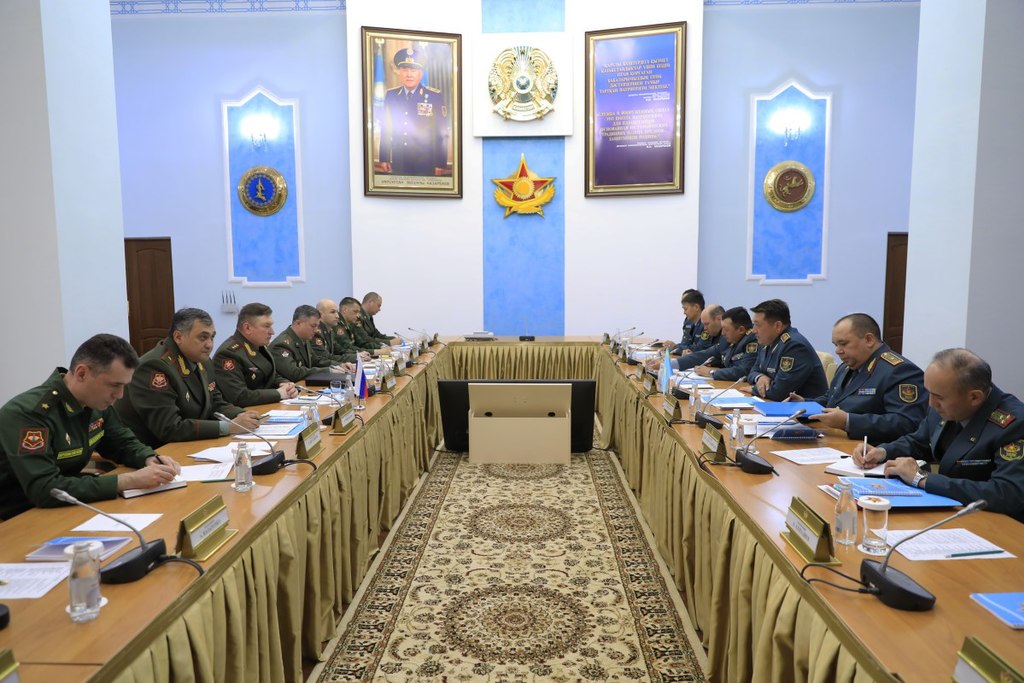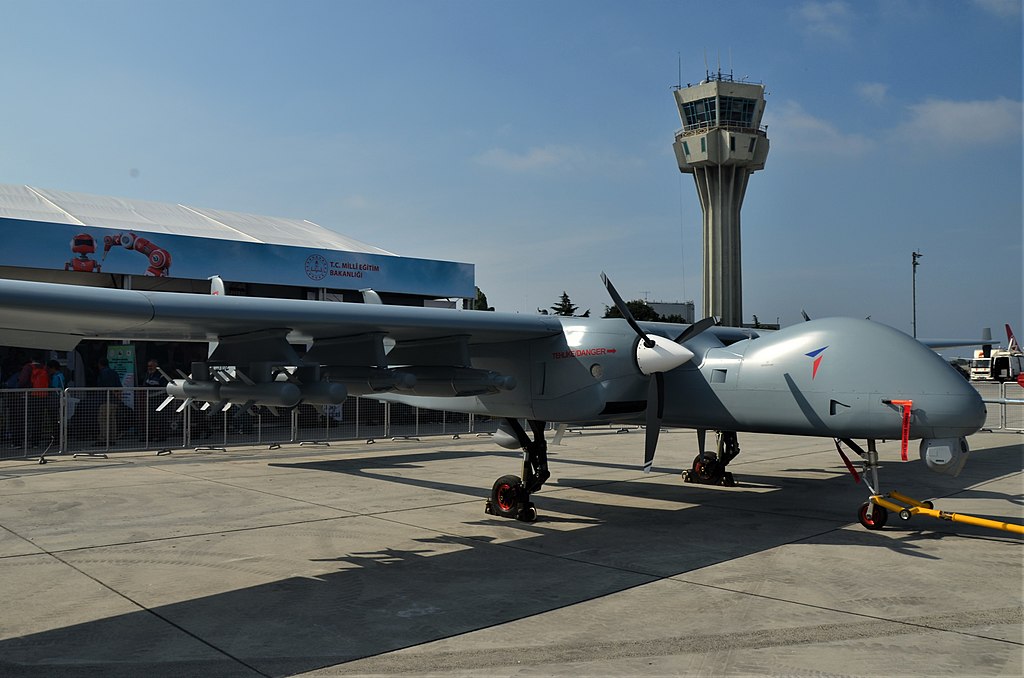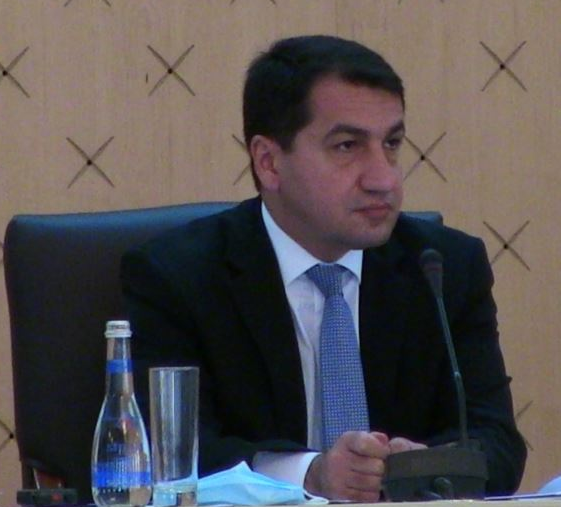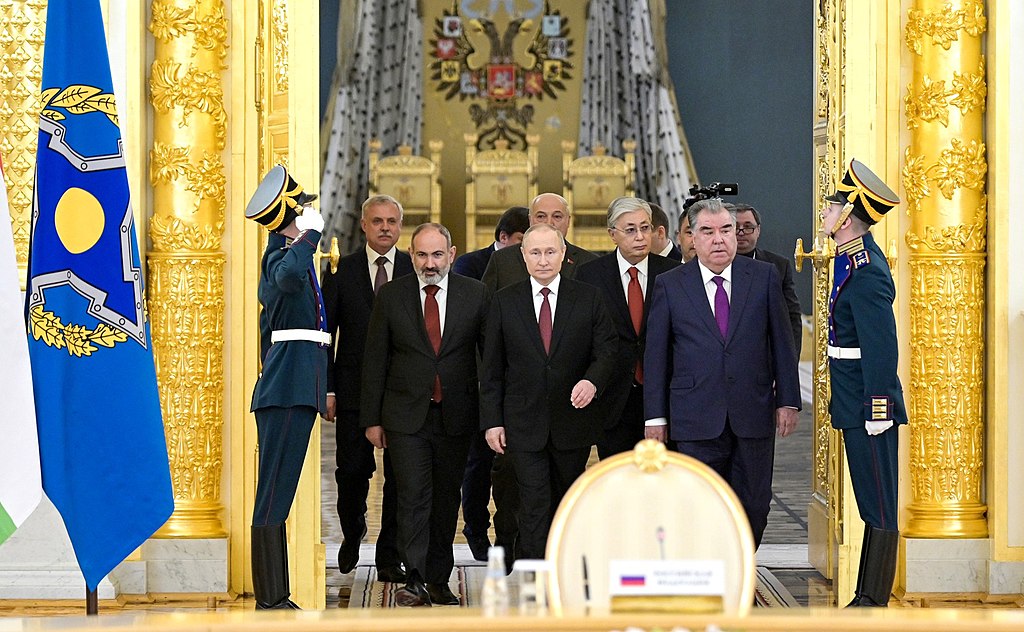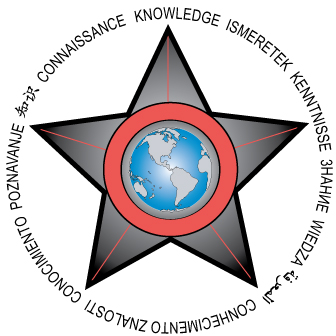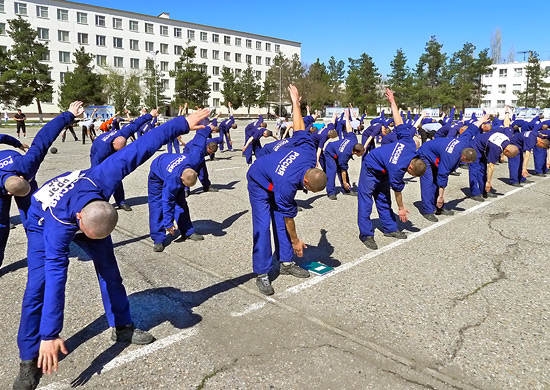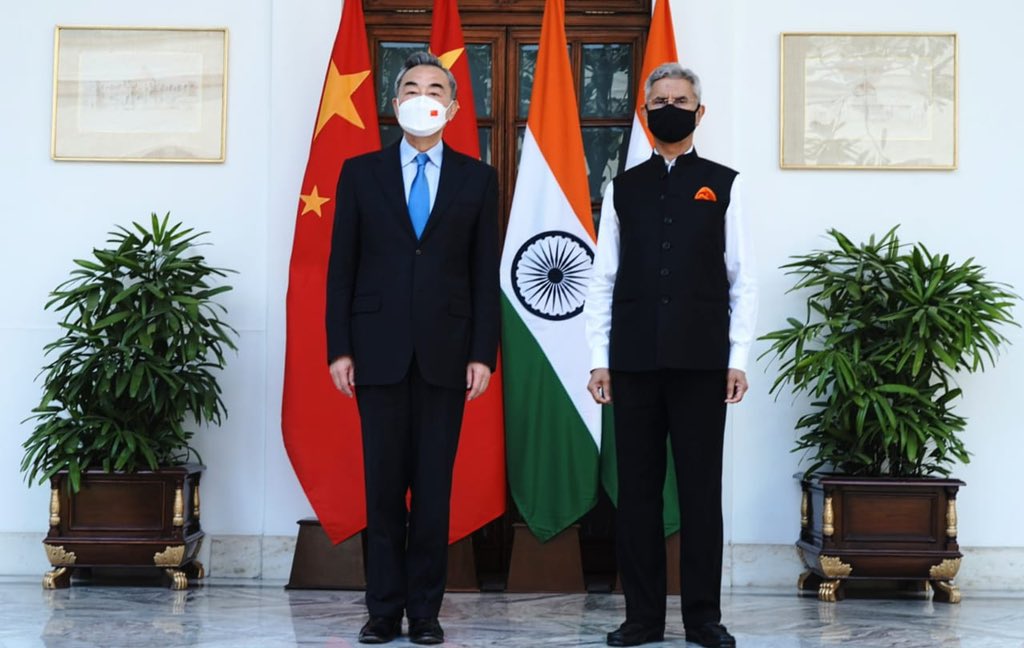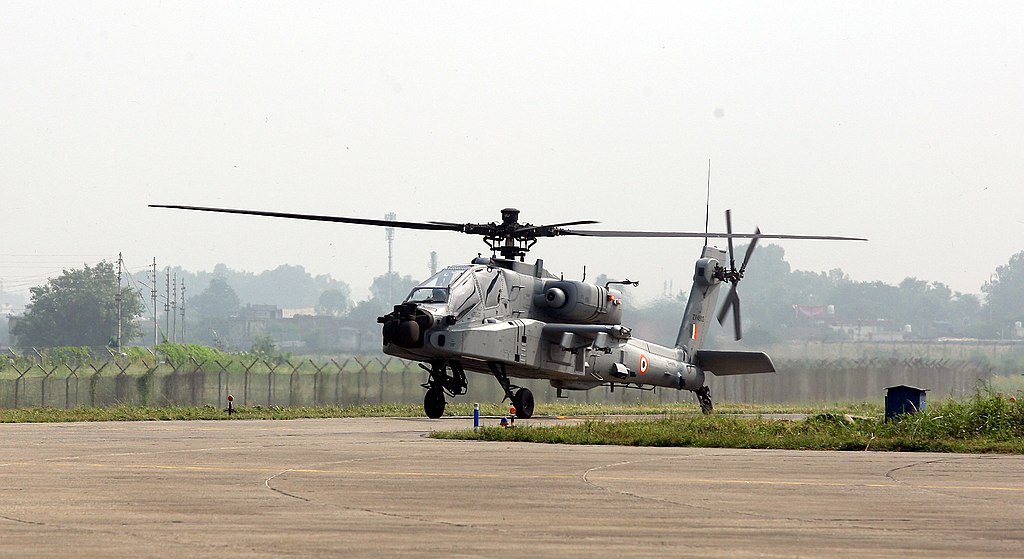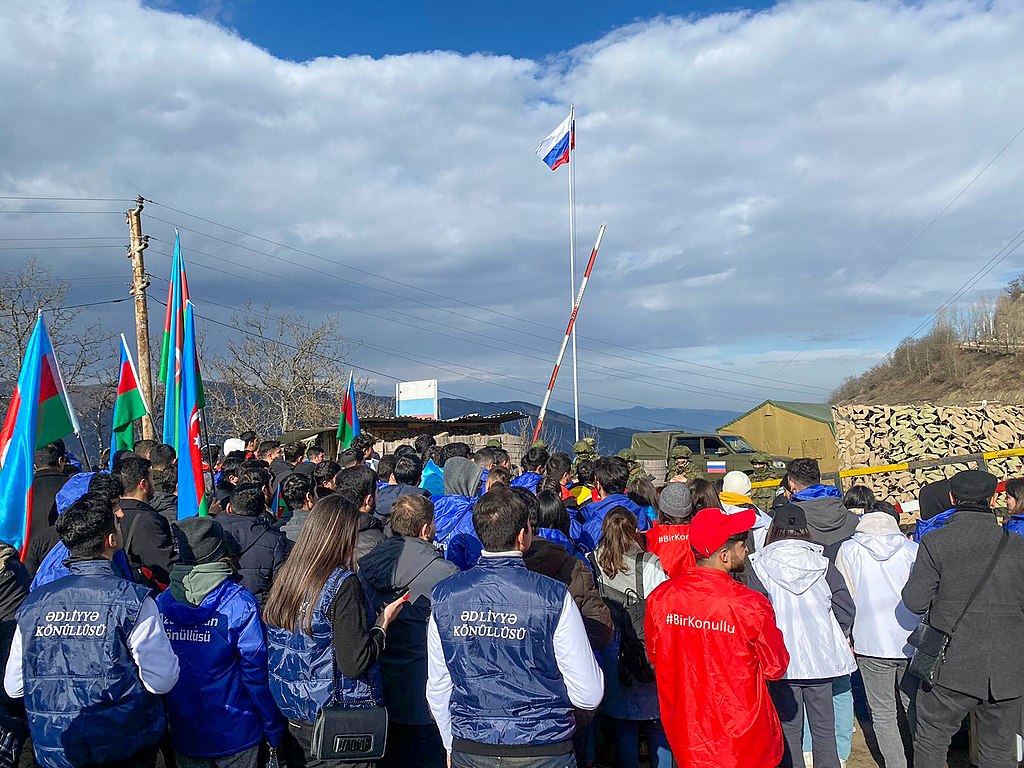Azerbaijani protesters during the 2022 blockade of the Lachin corridor.
“Thus, the corridor was blocked by two checkpoints — an “ecological” and a “peacekeeping” one. The peacekeepers are not letting ecologists enter Stepanakert, but they’re also not interfering with their blocking of the highway.”
On 5 March 2023, a clash took place in the Lachin Corridor, which connects Armenia with the Armenian-occupied region of Nagorno-Karabakh. The fight between Azerbaijani soldiers and Armenian policemen left five dead. The Lachin Corridor remains the only road connecting ethnic Armenians in Nagorno-Karabakh with Armenia following the ceasefire agreement that ended the 2020 war. The blockade is being carried out by so-called “ecologists” from Azerbaijan, who have stated they are concerned that mining operations in Nagorno-Karabakh are having a negative environmental impact on the region. However, there have been reports that the “ecologists” are likely working for the government of Azerbaijan. The incident brought increased attention to Azerbaijan’s ongoing blockade of the Corridor, which effectively cut off a significant lifeline for ethnic Armenians in Nagorno-Karabakh. The blockade also raises questions about the role Russian peacekeepers have in the Lachin Corridor, as well as Armenians who are using routes outside the main road in the corridor to travel to Nagorno-Karabakh. While the incidents have not spiraled out of control into a larger conflict between Azerbaijan and Armenia, they have added to what has been an unstable situation since the 2020 war ended.[i] The accompanying excerpted articles provide a look at the issues causing incidents in recent months between Azerbaijani and Armenian forces.
The first article from the independent English-language newspaper Novaya Gazeta Europe is a reporter’s account of traveling to Nagorno-Karabakh and includes interviews with regional analysts on the situation since the blockade by Azerbaijani ecologists began in December 2022. The author details numerous issues for those trying to travel to Nagorno-Karabakh via the Lachin Corridor, including the cost to be escorted there and having to pass through multiple checkpoints. The author points out how “Azerbaijan is building very expensive roads from its side, carving tunnels in the mountains,” as part of an effort to not only cut off the Lachin Corridor, but also control additional routes to Nagorno-Karabakh. Another analyst interviewed for the article claimed that Armenians are using the corridor to transport military cargo and that vehicles continue to travel to Nagorno-Karabakh despite the ecologists’ blockade. The article also notes how the blockade has remained in place even after outside efforts to end it, including Putin’s attempt to maintain leverage in Nagorno-Karabakh and the wider region through the appointment of ethnic Armenian Ruben Vardanyan to the office of State Minister in Armenia. Vardanyan was later dismissed, reportedly at the request of Azerbaijani President Aliyev during negotiations to end the blockade. The second article from Armenia’s state news agency Armenpress offers insight into an 11 April incident near the Lachin Corridor. While the article presents only the Armenian perspective, which blamed Azerbaijan for instigating the incident, the article notes that the Armenian military had been carrying out engineering work. It is unclear if this work is for a road or a defensive position, but it is taking place near the corridor. With the ongoing blockade by Azerbaijani ecologists and both Armenia and Azerbaijan constructing and using roads in and around the Lachin Corridor to their own advantage, additional skirmishes are likely, increasing the chance of escalation to a wider conflict.
Source:
Irina Tumakova, “‘The thing I miss the most? Freedom’,” Novaya Gazeta Europe (independent English-language newspaper), 24 March 2023. https://novayagazeta.eu/articles/2023/03/24/the-thing-i-miss-the-most-freedom-en
While I was coming down the Lachin mountain serpentine, my phone started vibrating. It was someone from the Russian military base, which, as is commonly believed, maintains peace and security in the small part of Karabakh that is still controlled by the unrecognised republic. “Andrey Valeryevich,” the man from the Russian peacekeepers base introduced himself shortly. “I was told you want to cross over to Stepanakert. Why?”
I explained that I had to see how people in Nagorno-Karabakh are living under the blockade organised by Azerbaijani eco-activists.
“The blockade?” Andrey Valeryevich chuckled. “They’re doing great, better than before! It’s us, peacekeepers, who’re under the blockade. The prices are crazy! Take a dozen eggs — three hundred rubles [€3.6] in Russian money. Isn’t that crazy? Three hundred! These ‘blockade victims’, these Armenians, are the ones selling us eggs at such prices!”
…“There’s a passage to get into Karabakh, but it costs money, 150 thousand [Armenian] drams [about €360] per person,” Armenian politologist Andrias Gukasyan tells me a few days later. “You have to first go to the Russian peacekeepers base in Goris. Why are you so surprised? You’ve come from Russia, you know what it’s like…”
…From the Armenian side, the border is guarded by an Armenian military police post. This is where Karabakh’s blockade begins. There’s another post like that in Stepanakert, in between the two there are Russian peacekeepers and Azerbaijani “ecologists” who organised the blockade.
…Karabakh and Armenia are connected via the Lachin corridor in the mountains. The corridor’s width is stated at 22 km. In reality, it’s a narrow highway where even two cars aren’t always able to let each other pass…Driving here is hard and dangerous, so Azerbaijan is building very expensive roads from its side, carving tunnels in the mountains…
According to the trilateral agreement signed on 9 November 2020, Azerbaijan pledged not to interfere with Armenians’ coming and going to and from Karabakh. The corridor has to remain under the control of Russian peacekeepers, they’re the ones ensuring the aforementioned freedom of movement.
On 12 December 2022, the road was blocked by people from Azerbaijan. They referred to themselves as eco-activists who had to verify the compliance with the environmental protection norms on two Karabakh mines — the Drmbon mine and the Kashen mine…Thus, the corridor was blocked by two checkpoints — an “ecological” and a “peacekeeping” one. The peacekeepers are not letting ecologists enter Stepanakert, but they’re also not interfering with their blocking of the highway…
“After the death of police officers (on 5 March, a car of the unrecognised republic’s police department was shot at, three police officers were killed — editor’s note), we went to the Russian peacekeeper contingent, we wanted to express our protest against everything going on. There’s a lot of blame on our locals too when it comes to the police officers’ death…”
“According to the trilateral agreement, this road is a humanitarian corridor to connect Armenia with Armenian residents of Karabakh,” this is how Azerbaijani political analyst Ilhar Velidaze explains the recent protests in the Lachin corridor. “However, we are able to follow the cargo movement through satellites and we have observed several times that the road is used for military cargo too, as well as soldiers coming in from Armenia. We couldn’t just act indifferently…Unfortunately, the Armenian side is trying to misrepresent the situation as a humanitarian catastrophe,” he notes. “But there’s no catastrophe to speak of. Take a look at the so-called ‘blockade’…During the last three months of the Azerbaijani activists’ protest, the Lachin road was used by over 4,000 vehicles that were transporting various cargo, furthermore, these are heavy-duty vehicles. Can this be called a blockade?”
“Putin sent Ruben Vardanyan to Karabakh as his representative,” Arif Yunusov, Head of the Conflictology Department of Azerbaijan’s Institute of World and Democracy, notes. “He was conducting secret talks about these mines, but they fell through. But for Putin, the main thing wasn’t the mines. Russia, dissatisfied with Pashinyan, assumed that Vardanyan would gain power in Karabakh, the next step being his candidacy as Armenian Prime Minister…You may recall how Presidents [Robert] Kocharyan and [Serzh] Sargsyan came into power, they’re from Karabakh too. Karabakh is a jumping off point.”
Ruben Vardanyan, Russian billionaire of Armenian origin, came back to Armenia in September of last year, went to Karabakh, and was appointed State Minister… In February, it came out that Vardanyan was dismissed from his position, as per the condition put forward by Azerbaijani President Ilham Aliyev. That was soon after the UN International Court of Justice demanded the Lachin corridor be unblocked. But the “ecologists” pickets remained.
…When the condition of Vardanyan’s dismissal was fulfilled, Azerbaijan brought forward another one — this one has as much to do with the environment and ecologists (nothing)…“Now, they’re demanding there be a checkpoint built on that road because the Armenians are allegedly transporting weapons into Karabakh,” Arif Yunusov says…
“Азербайджанцы потребовали от армянских военнослужащих прекратить инженерные работы: подробности о провокации в селе Тех (Azerbaijani demanded that Armenian soldiers halt engineering work: details on the provocation in the village of Tegh),” Armenpress (state news agency of Armenia), 12 April 2023. https://armenpress.am/rus/news/1108490.html
…Presenting the details of the Azerbaijani provocation near the village of Tegh on April 11, Khachatryan said that under the pretext of negotiations, an Azerbaijani car drove up to the Armenian positions from the territory controlled by them and demanded that the Armenian military personnel stop engineering work……On April 11, at about 16:00, on the territory of the Republic of Armenia, near the village of Tegh, Syunik region, a group of servicemen of the Azerbaijani Armed Forces, under the pretext of clarifying the border points of deployment, approached the servicemen of the RA Armed Forces, further provoked them, opened fire in the direction of the servicemen and positions of the Armenian Armed Forces…As a result of the Azerbaijani provocation from the Armenian side, there are 4 dead and 6 wounded. As of 0800 April 12, the situation on the front line remains relatively stable.
Notes:
[i] For more background on incidents between Armenia and Azerbaijan since the 2020 war ended, see: Matthew Stein “The Impact of Territorial Changes in Nagorno Karabakh,” OE Watch, July-2021. https://community.apan.org/wg/tradoc-g2/fmso/p/oe-watch-issues
Image Information:
Image: Azerbaijani protesters during the 2022 blockade of the Lachin corridor.
Source: https://commons.wikimedia.org/wiki/File:Azerbaijani_protesters_during_the_2022_blockade_of_the_Lachin_corridor_03.jpg
Attribution: CCA 4.0
